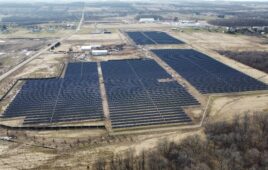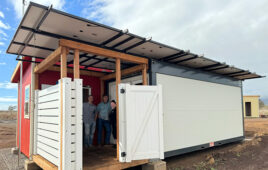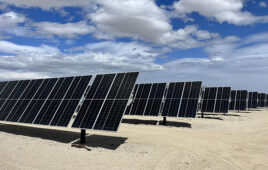Solar backtracking is a tracking control program that aims to minimize PV panel-on-panel shading, thus avoiding production losses. When a tracker, or a linked tracker row, is used near another, it shades the adjacent tracker during early morning and late afternoon hours.
Photo: Array Technologies, Inc.
The backtracking algorithm is implemented to drive the panels’ position during these periods of low solar height, said Laurent Sarrade, global product manager at Exosun.
Though the angle of the panels is not optimal, the loss from the off-angle is typically less than the loss that would result from shading the panels, added John Williamson, director of engineering at Array Technologies.
When a single cell in a crystalline module is shaded, it affects the power production of the entire module.
“For example, if half of a single cell is shaded, the panel will reduce in power output by about 50%. By backtracking, losses due to shading are eliminated, optimizing the amount of power that the panels can produce,” Williamson said.
This increase in power production widens the “shoulders” of the power production curve for any given day, and results in a better LCOE.
There are no additional costs to enable backtracking. Williamson acknowledged an up-front cost for the development of the product, but it’s small in comparison to the benefits gained from shade prevention.
The amount of backtracking performed on average should be minimized for a site to produce the maximum amount of power, however. When laying out a site, it’s important to keep the field density to a minimum to allow for greater spacing between rows, which means less backtracking.
Sarrade asserted that any serious tracking system provider should be able to propose a basic backtracking program, citing Exosun’s patented tracking process SMARTracking.
“If the system is simply based on a light sensor and feedback system, it is much more difficult to make backtracking function properly,” Williamson explained. “Most astronomical algorithm-based control systems can be programmed with backtracking.”
When a tracker is stand-alone and doesn’t have adjacent trackers or tracker rows, backtracking is not typically required. Some PV panels are not as sensitive to shading, and some thin film modules do not decrease power output if a single cell is shaded. However, running simulation software to determine whether backtracking is needed is suggested. Backtracking is never completely unnecessary, Sarrade said.





How does PV Syst account for backtracking? We are working thru a few projects using ATI and finding the near shading losses are higher than expected with backtracking.
Can we have both open loop backtracking and closed loop sensor tracking in one control unit?
I mean in early morning and late afternoon it switches to backtracking and during day to its sensor tracking.
Best Regards
Zargham Ali
I’m not sure about direct switching, but tracking companies are moving to more optimized algorithms. Here’s what NEXTracker, Soltec and ATI are doing: https://www.solarpowerworldonline.com/2018/11/smart-tracking-technology-updates-usher-in-new-era-of-increased-energy-harvest-on-large-scale-sites/